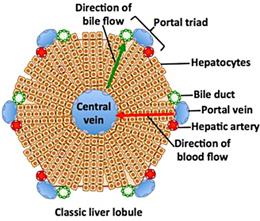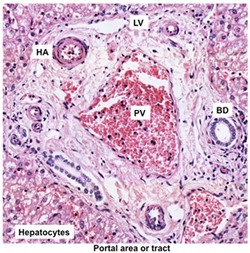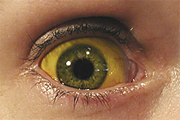The liver is responsible for
many diverse functions, including endocrine (e.g. production and
secretion of plasma proteins), exocrine (e.g. bile production), and
metabolic (glucose production, storage of nutrients and vitamins,
deamination of amino acids, and detoxification of drugs and toxins)
functions.  The liver is unusual in that it is supplied by both
arterial blood (providing oxygen) and venous blood (containing
nutrients for processing) from the portal circulation that mixes
with arterial blood prior to perfusing the hepatocytes. The liver is unusual in that it is supplied by both
arterial blood (providing oxygen) and venous blood (containing
nutrients for processing) from the portal circulation that mixes
with arterial blood prior to perfusing the hepatocytes.
Review
the structural organization of the liver (hepatic) lobule, noting
inflow of blood to lobules from branches of both the hepatic artery
and hepatic portal vein and outflow through central venules to
branches of the hepatic vein. Bile originates within lobules and is
drained via branches of the bile duct located in the portal areas. A
simplified version of the classic liver lobule in transverse section
is shown in the diagram to the right.
Click here for a larger view.
-
 The
liver histology is complex, but this
narrated overview
of the liver will help explain things. Try it. The
liver histology is complex, but this
narrated overview
of the liver will help explain things. Try it.
-
Examine these sections of liver
(sample 1,
sample 2,
sample 3). With
low magnification, locate a set of portal areas (triads)
outlining a lobule.
- With higher power, identify the
central venule in the center of the lobule and the triad of
components in the portal area, namely branches of the hepatic portal
vein (PV), hepatic artery (HA), and bile ductules (BD). The portal
areas also contain lymphatic vessels (LV) with their typical thin
endothelium and irregularly shaped lumens. Use the image at the
right to help you locate these structures.
 Clinical
note: Hepatitis involves infection or inflammation of
hepatocytes and other epithelial components in the liver. Cirrhosis
involves excessive proliferation of fibroblasts and collagen
deposition in the stroma of the liver. Hepatocytes have a remarkable
capacity for regeneration, but chronic, long-term alcoholism leads
to the death of these cells and cirrhosis. Jaundice, due to failure
of the hepatocytes to conjugate bilirubin, is characterized by
accumulation of bilirubin in the skin and sclera of the eyes.
Jaundice is common in patients with liver disease. Clinical
note: Hepatitis involves infection or inflammation of
hepatocytes and other epithelial components in the liver. Cirrhosis
involves excessive proliferation of fibroblasts and collagen
deposition in the stroma of the liver. Hepatocytes have a remarkable
capacity for regeneration, but chronic, long-term alcoholism leads
to the death of these cells and cirrhosis. Jaundice, due to failure
of the hepatocytes to conjugate bilirubin, is characterized by
accumulation of bilirubin in the skin and sclera of the eyes.
Jaundice is common in patients with liver disease.
Detail of the
hepatic lobule. |